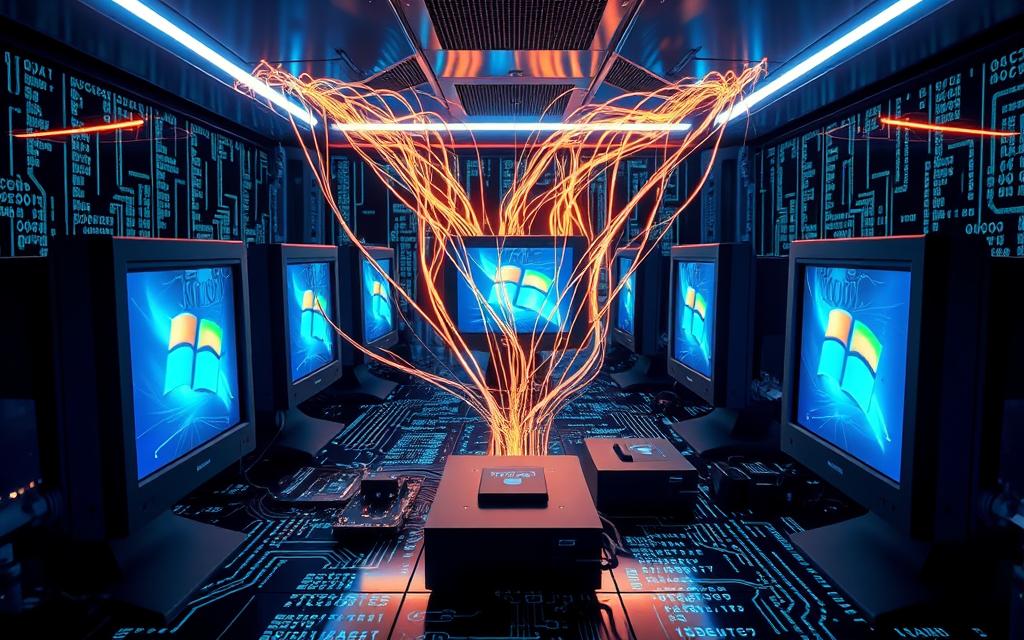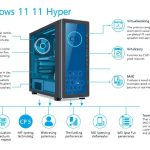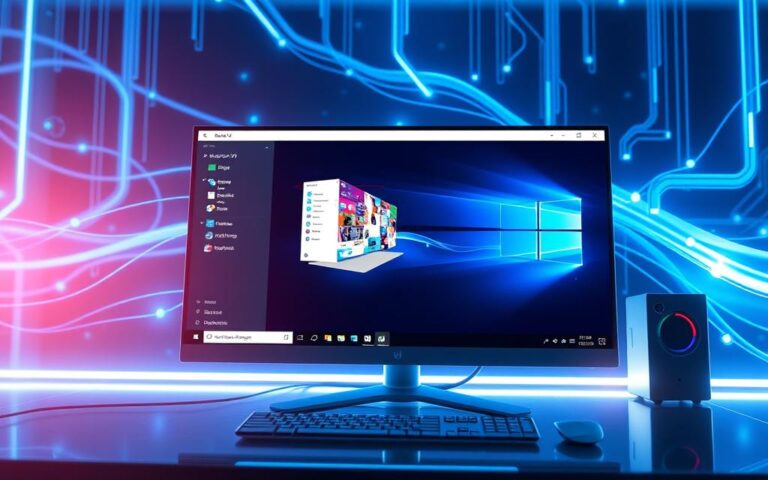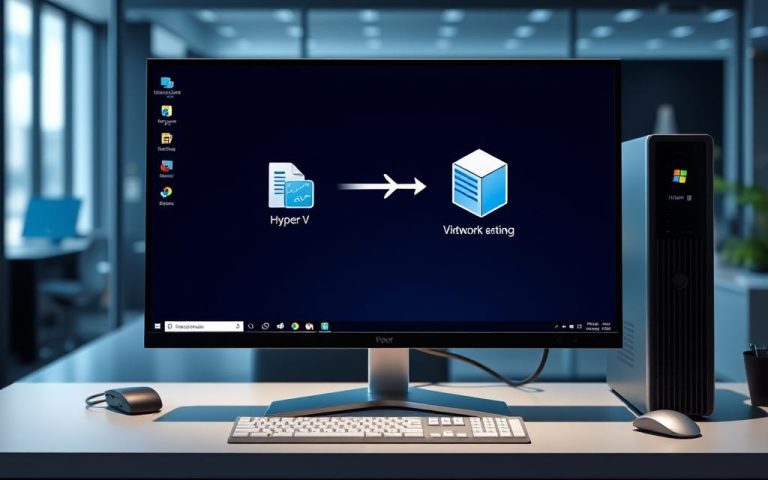Exploring Hyper-Threading in Windows 2000
The hyper-threading technology by Intel marks a big step forward for computing power. It lets Windows 2000 run several threads at once on a single core. This makes better use of the computer’s resources.
We’re going to look into how hyper-threading works in Windows 2000 and how it helps performance. By using this technology, users can get more from their computers. But it’s important to know about possible issues with compatibility and licensing. Knowing about these can help users make the most of hyper-threading.
Understanding Hyper-Threading Technology
Hyper-Threading is a brilliant technology made by Intel. It changes how computers work for the better. This technology lets a single physical processor act as two logical ones. It makes computers better at doing many things at once.
What is Hyper-Threading?
Intel introduced hyper-threading technology in February 2002. It first appeared in Xeon server processors and then in Pentium 4 desktop processors in November 2002. This design lets the operating system use two virtual cores for each real one. So, it can do two tasks at the same time on each core, improving efficiency.
How Hyper-Threading Works
Hyper-threading allows one core to handle two threads at the same time. This feature boosts performance, especially when the computer is very busy. Intel said this could improve performance by 15-30% thanks to better use of processor resources.
The Nehalem microarchitecture, released in November 2008, brought hyper-threading back in a big way. It was in the Core i7, allowing work on four to twelve threads. This move boosted computing power using a smart two-way hyper-threading approach in Intel Xeon 5500 servers. However, some apps might run a bit slower when two processes want the same resources.
Hyper-Threading Windows 2000: Compatibility and Limitations
Windows 2000 has limited Windows 2000 compatibility with Intel’s Hyper-Threading technology. It only recognises the first logical processor of each CPU. This is due to license restrictions. As a result, much of the processing power is not used, especially in multi-processor systems.
When looking at Hyper-Threading limitations in Windows 2000, performance issues arise. For example, in a system with four CPUs, only one processor per CPU is used. However, Windows 2000 Server supports up to four CPUs. Windows 2000 Advanced Server can go up to eight CPUs. Meanwhile, Windows .NET Server handles Hyper-Threading much better by efficiently using logical processors.
Users of Windows 2000 face challenges due to the need for suitable Intel processor support. They often see misleading performance results with Hyper-Threading on. This is because Windows 2000 struggles with dual-threaded systems. Performance varies depending on the type of application and system setup. This makes Windows 2000 a complex option for those wanting to make the most of Hyper-Threading.
Windows 2000 was a start for multi-threaded processing, but it doesn’t fully meet modern needs. Those wanting to use Hyper-Threading fully might prefer newer operating systems. For in-depth information on Hyper-Threading and its effect on performance, check this link.
Comparing Performance: Windows 2000 vs. Windows .NET Server
We look at the difference between Windows 2000 and Windows .NET Server. We see big changes in how they use Hyper-Threading technology. Windows 2000 has its merits, but Windows .NET Server really makes the most of new hardware to give users a smooth experience.
Performance Expectations
Windows .NET Server steals the spotlight with better handling of logical processors thanks to Hyper-Threading. Microsoft expects big improvements with this newer system. You can look forward to a 30% boost in performance with just one logical processor. This is rather than splitting it into two physical ones. But, Windows 2000 shows small improvements because it doesn’t fully use Intel Xeon MP and symmetric multithreading. This is due to some license and BIOS interpretation issues.
Tests have shown clear differences in performance. Windows .NET Server does much better under heavy loads compared to Windows 2000. Using the IBM HTTP Server, it managed loads better and stayed stable. This is even with lots more client requests. However, Windows 2000 didn’t handle increased demand as well.
Licensing Implications
Licensing makes a big difference in how Windows 2000 and Windows .NET Server work. Windows 2000 faced limits that might stop it from using Hyper-Threading fully. If Microsoft had made a simple update to support it, performance could have been better. But, licensing issues got in the way.
To sum up, Windows 2000 is okay, but for top performance, Windows .NET Server is the better choice. It’s built to make the most out of your hardware, making it perfect for many businesses.
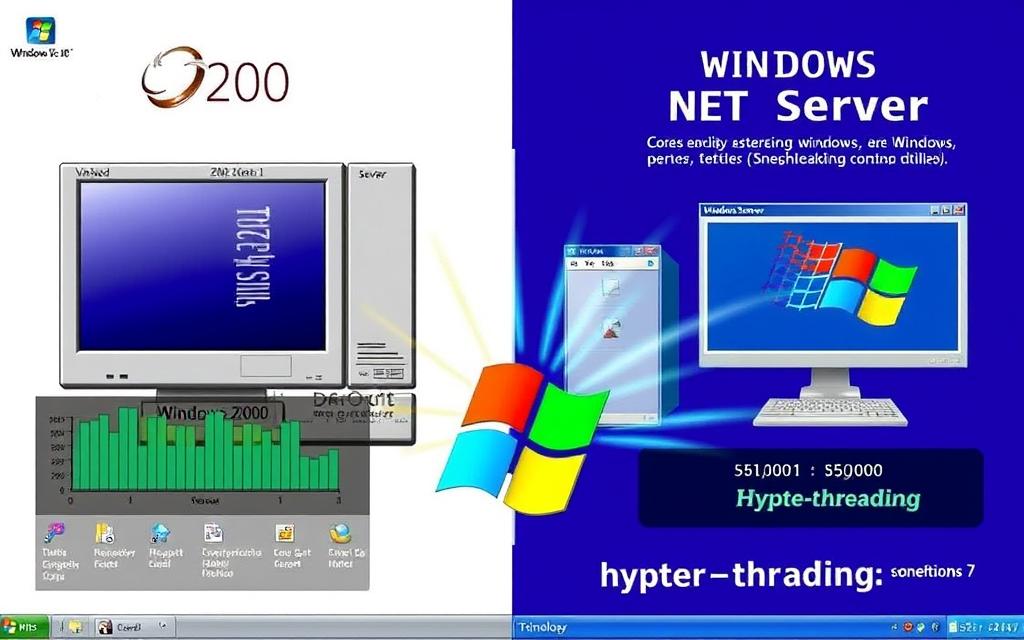
Benefits and Drawbacks of Hyper-Threading in Windows 2000
Hyper-Threading technology brought both pros and cons to Windows 2000 users. It’s important to understand these to know if it meets their needs.
Benefits of Hyper-Threading
One key benefit of Hyper-Threading in Windows 2000 is better use of resources. It allows two threads to process at the same time. This improves performance for apps that work with many threads.
This means tasks can be done more efficiently. For example, performance can improve by up to 20% in some apps with Hyper-Threading. Apps made for many processors can run faster on Hyper-Threading CPUs without big changes. Using Intel’s OpenMP C++/Fortran Compilers can automatically or semi-automatically make code better, boosting performance further.
Drawbacks to Consider
However, Hyper-Threading in Windows 2000 isn’t perfect. It has some drawbacks. For instance, one task could slow down the second logical processor, dropping overall performance. Other issues to think about include:
- Programming becomes more complex with multi-threading.
- New bugs might appear, especially those that come from threads fighting over resources. This can make the system less reliable.
- Windows 2000 and Windows NT were not made for Hyper-Threading. So, it might not work well in some cases.
If you’re diving into the world of cookies and data use on different sites, consider learning more. Check out our cookie policy for details.
| Aspect | Benefits | Drawbacks |
|---|---|---|
| Resource Utilisation | Enhanced due to dual-thread processing | Can lead to performance degradation |
| Performance Gains | Up to 20% improvement | Not all applications optimized for Hyper-Threading |
| Complexity | Supports multi-threading functionality | Increased programming complexity |
| Reliability | Simplifies task handling in multi-task environments | New bugs may arise, affecting system reliability |
Conclusion
When we look at Hyper-Threading in Windows 2000, we find both big pluses and tough challenges. This tech makes the processor work better. It lets two threads run on each core. This means computers can do many tasks at once much better. But, the benefits vary. Some programs get faster, especially if they use many threads. Others, that use just one thread, might not get much faster.
Thinking about using Hyper-Threading? Then, it’s important to look at what it means for Windows 2000. This feature could make some tasks 10-15% faster under the right conditions. However, a big issue known as the “memory wall” could limit these benefits. It’s wise to think carefully before adding this tech to old systems.
Technology in computing keeps changing, and we need to keep up. Understanding Hyper-Threading can help us make our computers run better. It’s about matching the new tech with what we need while dealing with older system challenges. The quest for using new innovations in tech is a continuous one. By making smart choices, we can improve our computers’ performance a lot.
FAQ
What is Hyper-Threading?
Hyper-Threading is a technology developed by Intel. It allows one physical processor to work like two logical ones. This boosts CPU performance by enabling the processor to handle multiple threads at once. It makes running different applications at the same time smoother.
Can Windows 2000 fully utilise Hyper-Threading Technology?
No, Windows 2000 can’t fully use Hyper-Threading. It only recognises the first logical processor for each CPU. This is due to licensing issues. So, the full advantages of Hyper-Threading aren’t achieved.
What are the main benefits of Hyper-Threading in Windows 2000?
The key benefits of Hyper-Threading in Windows 2000 include better use of resources. It also increases efficiency when running applications that use multiple threads. This is especially helpful when many tasks are done at the same time.
How does Hyper-Threading compare in Windows 2000 and Windows .NET Server?
Windows .NET Server can fully use Hyper-Threading, giving it better performance over Windows 2000. Windows 2000 has limited Hyper-Threading support, offering only slight improvements. This is because it doesn’t fully recognise dual-threaded architecture.

